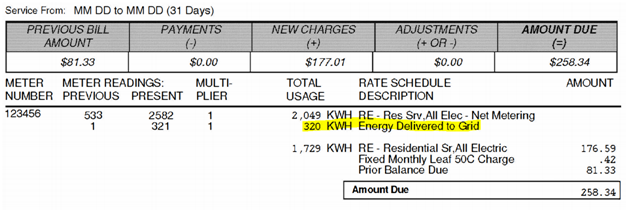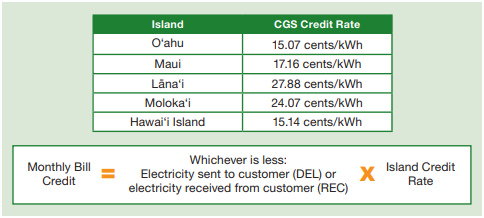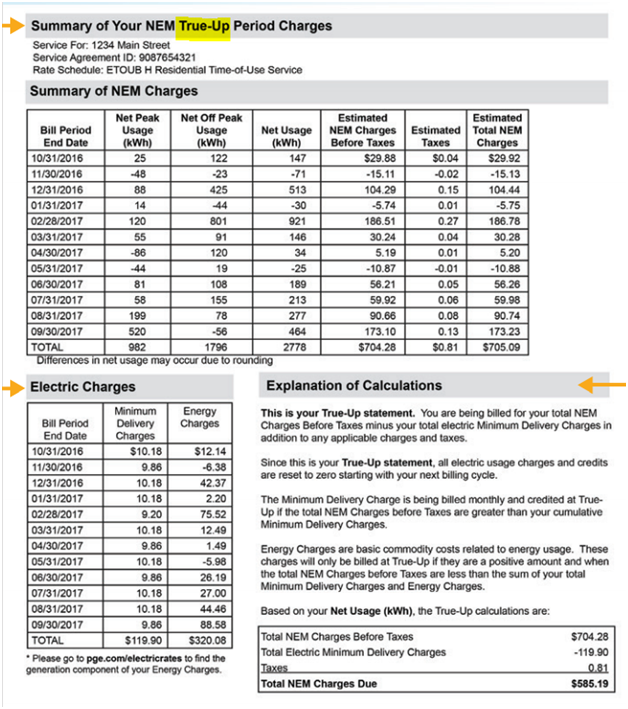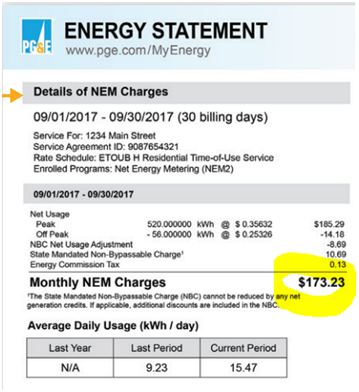The following table summarizes the different cases of how to track energy savings with solar PV systems.
| Case | When Was Solar Installed? | ESCO Wants to Track Solar Savings | Rate Case | Baseline | Variables | Modification | Actual |
| 1 | Before ESP | No | Case 1: Same rate for buying or selling kWh | Bill kWh | Try to regress with solar insulation or % Sunlight | None | Bill kWh |
| 2 | As part of ESP | Yes | Case 1: Same rate for buying or selling kWh | Bill kWh | None | None | Bill kWh |
| 3 | As part of ESP | No | Case 1: Same rate for buying or selling kWh | Bill kWh | None | Negative Solar Produced kWh | Bill kWh |
| 4 | During Performance Period | No | Case 1: Same rate for buying or selling kWh | Bill kWh | None | Negative Solar Produced kWh | Bill kWh |
| 5* | Before ESP
As part of ESP |
No | Case 2: Different rates for buying or selling kWh | Grid kWh | Try to regress with solar insulation or % Sunlight | None | Grid kWh |
| Solar to Grid kWh (negative) |
Solar to Grid kWh (negative) |
||||||
| 6* | As part of ESP | Yes | Case 2: Different rates for buying or selling kWh | Grid kWh | None | None | Grid kWh |
| Solar to Grid kWh = 0 | Solar to Grid kWh (negative) |
||||||
| 7 | Before ESP | No | Case 2: Different rates for buying or selling kWh | Bill kWh | None | Negative Solar Produced kWh | Bill kWh |
| 8 | As part of ESP | No | Case 2: Different rates for buying or selling kWh | Bill kWh | None | Negative Solar Produced kWh | Bill kWh |
*Cases 5 and 6 require 2 meters, one for Grid kWh, one for Solar to Grid kWh
More Specific Utility Pricing Issues
How Utilities are Handling Buying and Selling of Electricity
One major problem with net metering is that when the rate payer contributes energy to the grid, the rate payer is compensated in different ways depending on the utility. We have identified three different methods the utilities are using to cost net metering below. If you want a more complete rule book, then you will have to multiply the three net metering rate arrangements by the eight cases we went through, which would result in 24 unique cases. And what is worse, there are surely more methods to apply costing than these three.
Below are the three cases that we have uncovered.
Duke Energy in North Carolina
Duke Energy in North Carolina will credit the ratepayer for the contribution to the grid, but on the following month’s bill. Duke rates are Class 2 rate. The utility pays much less per kWh than it charges. This is not made explicit on the utility bill.
- So, what does this mean for our cases above? It should only be a problem if the solar system is large enough to be able to meet all of the building electricity needs during peak hours and has some left over. Often this is not the case, as solar PV systems do not meet all of the electricity load.
- Assuming the solar PV system is large enough that it does supply excess kWh some months, then how are we going to handle entering the correct usage? We do not know what it is from the current month’s bill.
- In Cases 5 and 6, we need Grid kWh and Solar to Grid kWh. The bill provides the current month’s Grid kWh, the kWh provided from the Grid. The bill also provides the prior month’s Solar to Grid kWh.
- In Cases 7 and 8, there is no solar in the base year, so there is no complication for the baseline. For the performance period actual bills, we need Bill kWh, which is Net kWh, or Bill kWh = Grid kWh – Solar to Grid kWh. The bills do not explicitly state Bill or Net kWh. There are two ways you can handle this:
- You may have to track Grid kWh (from the current month’s bill) and Solar to Grid kWh (from the current month in next month’s bill) in a spreadsheet and take the difference between these, and enter them as the “Bill kWh” for the current month. That would give you the “correct” net kWh for the month.
- But the utility is not charging with the “correct” kWh. For this reason, it may be better to report in your bill register exactly what is shown on the utility bill: this month’s Grid kWh and last month’s Solar to Grid kWh. The utility is applying rates to the difference of these. You might choose to do what the utility is doing.
- Assuming the solar system is large enough to warrant a credit during some months, then these rate provisions mean that it might not be wise to use an average monthly $/kWh to apply costs to the energy savings, as the credit for this month is applied next month. You are most likely going to have to explicitly model the rate or agree with the client on some simpler representation of the rate.
Hawaiian Electric Company
Hawaiian Electric Company has phased out net metering for the new “smart export” program, and now compensates ratepayers nothing for electricity contributed to the grid from 9 a.m. to 4 p.m. The table below shows the rates used to credit ratepayers. Hawaiian Electric Company rates are Class 2 Rates.
Notice that the bill credit is the minimum of Grid kWh and Solar to Grid kWh. So, if a ratepayer sends 100 kWh to the grid, and only uses 50 kWh from the grid, then the credit will only be 50 kWh, which is NOT Solar to Grid kWh.
The credits are banked, and can then be applied to the same month’s bills. After 12 months, there is a True Up bill, where after any credits are applied to this 12th bill, the remaining credits expire and become worthless.
- So, what does this mean for our cases above? It should only be a problem if the solar system is large enough to be able to meet all of the building electricity needs during peak hours and has some left over. Often this is not the case, as solar PV systems do not meet all of the electricity load.
- If you are dealing with Case 7 or Case 8, you can ignore this complication. You won’t be tracking Solar to Grid kWh.
- Assuming the solar PV system is large enough to contribute to the grid during peak hours, then if you are dealing with Case 5 or Case 6, then you are probably going to change how you track kWh.
- First, you will have to break out Solar to Grid kWh by TOU period.
- You will need to model the rates explicitly.
- When you enter into the Solar to Grid kWh meter’s register, it is most likely you will be entering the Solar to Grid kWh, but you should make sure that the building takes more kWh than it provides. If it does not, then you may need to look every month at the bill to determine the minimum of Grid kWh and Solar to Grid kWh.
PG&E in Northern California
PG&E in Northern California bills solar clients a minimum connection charge and tracks the net energy that is being provided by the utility. Net kWh = Bill kWh = Grid kWh – Solar to Grid kWh. At the end of a billing year, the utility sends a true-up bill, in which the ratepayer is charged or given a credit for all of the power they contributed and/or took from the grid. The monthly bills are small, but the annual true up bill can be very large. PG&E and the other California investor owned utilities (SCE, SDG&E), buy and sell kWh at the same rate. But, there is one exception. If there is a net credit due to the ratepayer at the end of the year, the utility will pay a market rate per kWh ($0.03 to $0.04) rather than the retail rate.
- Because PG&E buys and sells kWh at the same price, PG&E is considered Rate Case 1.
- You should not use the average $/kWh when you are applying costs to the energy savings, since there are probably TOU periods. It is best to explicitly model the rate or agree with the client on some simpler representation of the rate.
- If you do choose to use average $/kWh, use the Monthly NEM Charges, as shown below to calculate the average cost.
Pricing Problems
The way that pricing is handled can further complicate your estimation of savings.
- If the PV was installed before the energy savings project, does the client have a PPA? If so, then I think you merely need to use the PPA’s rate, which is probably much simpler than the utility rate.
- If the ESCO provided the PV, did the ESCO put a PPA in place? Or is the ESCO selling energy to the client at a lower price than the client is paying now? This means you get to use the ESCO rate, which is probably much simpler than the utility rate.
- Is the client now on a different rate since installing the solar PV system? This only matters if the ESCO installed the solar PV system, or if the client installed the system during the performance period.
How Does Battery Storage Complicate Matters?
If a solar and battery storage combination is installed, the cases described here should be the same:
- Battery storage will offer the added benefit of cutting demand peaks.
- Solar PV that is produced in one TOU period may be used in a different TOU period. You will want to model your utility rates explicitly, or at least in TOU periods.
- You will need to track kW and model kW charges as well as kWh, as battery storage is primarily a demand reduction tool.
- You should be modeling your rates explicitly now, but many times performance contracts call for a stipulated simple rate.



